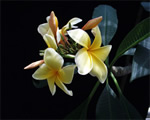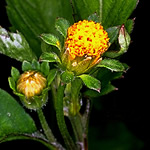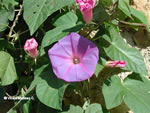
![]() White Frangipani (Plumeria obtusa)
White Frangipani (Plumeria obtusa)
 This
small tree grows to 8 m high and is best suited to a tropical climate where,
unlike most frangipanis, it is reliably evergreen. It can be grown in frost-free,
subtropical climates, but requires a sheltered position and a fairly constant
water supply. The broad, blunt-ended leaves are 15cm or more long. The scented,
creamy white flowers have a bright yellow center. with its elegant, rounded
flowers and soft perfume, 'Singapore White' is one of the loveliest of all
plumerias.
This
small tree grows to 8 m high and is best suited to a tropical climate where,
unlike most frangipanis, it is reliably evergreen. It can be grown in frost-free,
subtropical climates, but requires a sheltered position and a fairly constant
water supply. The broad, blunt-ended leaves are 15cm or more long. The scented,
creamy white flowers have a bright yellow center. with its elegant, rounded
flowers and soft perfume, 'Singapore White' is one of the loveliest of all
plumerias.
![]() k'anmul (Bidens pilosa)
k'anmul (Bidens pilosa)
 Picão
preto is a small, erect annual herb that grows to 1 m high. It has bright
green leaves with serrated, prickly edges and produces small, yellow flowers
and black fruit. Its root has a distinctive aroma similar to that of a carrot.
It is indigenous to the Amazon rainforest and other tropical areas of South
America, Africa, the Caribbean, and the Philippines. It is often considered
a weed in many places. It is a southern cousin to Bidens tripartita, the European
bur marigold, which has an ancient history in European herbal medicine. In
Brazil, the plant is most commonly known as picão preto or carrapicho;
in Peru it is known as amor seco or pirca.
Picão
preto is a small, erect annual herb that grows to 1 m high. It has bright
green leaves with serrated, prickly edges and produces small, yellow flowers
and black fruit. Its root has a distinctive aroma similar to that of a carrot.
It is indigenous to the Amazon rainforest and other tropical areas of South
America, Africa, the Caribbean, and the Philippines. It is often considered
a weed in many places. It is a southern cousin to Bidens tripartita, the European
bur marigold, which has an ancient history in European herbal medicine. In
Brazil, the plant is most commonly known as picão preto or carrapicho;
in Peru it is known as amor seco or pirca.
![]() Ipomoea Indica
Ipomoea Indica
 Herbaceous
perennial plant of the The Bindweed family - convolvulaceae - . Clambering
stems, alternate leaves, petiolated till 20 cm long, with three defined lobules.
Funnel-shaped flowers in groups of three, very noticeable; corolla till 9
cm. wide, pink, violet or white, with darker strips, that becomes closed at
midday. Cultivated plant, naturalised in many places and a real intrusive
plant of gardens and fields in many hot spots.
Herbaceous
perennial plant of the The Bindweed family - convolvulaceae - . Clambering
stems, alternate leaves, petiolated till 20 cm long, with three defined lobules.
Funnel-shaped flowers in groups of three, very noticeable; corolla till 9
cm. wide, pink, violet or white, with darker strips, that becomes closed at
midday. Cultivated plant, naturalised in many places and a real intrusive
plant of gardens and fields in many hot spots.
![]() Mangrove
Mangrove
 The
Mangrove is the most ecologically important plant of the Costa Maya, and all
beach environments. The mangroves are where many aquatic animals spend their
infancy and youth. The tangled roots provide refuge from the predators that
would otherwise eat them. The mangrove trees grow where the land meets the
sea and have adapted methods of eliminating the salt they intake from sea
water through special glands in some of their leaves.
The
Mangrove is the most ecologically important plant of the Costa Maya, and all
beach environments. The mangroves are where many aquatic animals spend their
infancy and youth. The tangled roots provide refuge from the predators that
would otherwise eat them. The mangrove trees grow where the land meets the
sea and have adapted methods of eliminating the salt they intake from sea
water through special glands in some of their leaves.
The mangrove is the major reason that beach erosion does not occur. The roots
and plant structure keeps the beach sand or mud in place and protects the
land from harm during tropical storms and general wave action. Mangroves actually
help form land and small islands, in the shallows. The mangroves in the Costa
Maya are protected plants and the cutting of them are strictly prohibited.
Stiff fines and even jail time is possible for their destruction.
Mangroves are any of certain shrubs and trees of the families Rhizophoraceae,
Verbenaceae, Sonneratiaceae, and Arecaceae (palm) that grow in dense thickets
or forests along tidal estuaries, in salt marshes, and on muddy coasts. The
term also applies to the thickets and forests of such plants. Mangroves characteristically
have prop roots (exposed, supporting roots). In addition, in many species
respiratory, or knee, roots project above the mud and have small openings
through which air enters, passing through the soft, spongy tissue to the roots
beneath the mud. Mangrove fruits put out an embryonic root before they fall
from the tree; the root may fix itself in the mud before the fruit separates
from the parent. Likewise, branches and trunks put out adventitious roots
which, once they are secure in the mud, send up new shoots. The common mangrove
(Rhizophora mangle) grows to about 30 ft (9 m) tall and bears short, thick,
leathery leaves on short stems, and pale-yellow flowers. Its fruit is sweet
and wholesome.
The 'Guerreros'
orchid and bromelia garden is set in the typical Costa Maya environment
of ponds and forest. In the forest you can also find other plants that are
often seen on the Costa Maya. There are lots of interesting birds and many
types of insects to be found. In the night small crocodiles come out to the
garden.
The garden is located on the Cafetal - Mahahual (Majahual) road approx. 7 km from Cafetal.